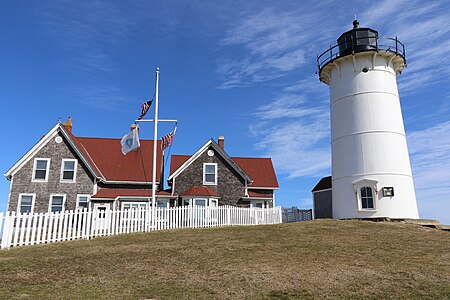Nobska Light
Falmouth, MassachusettsLighthouses completed in 1829Lighthouses completed in 1876Lighthouses in Barnstable County, MassachusettsLighthouses on the National Register of Historic Places in Massachusetts ... and 1 more
National Register of Historic Places in Barnstable County, Massachusetts

Nobska Light, originally called Nobsque Light, also known as Nobska Point Light is a lighthouse located near the division between Buzzards Bay, Nantucket Sound, and Vineyard Sound in the settlement of Woods Hole, Massachusetts on the southwestern tip of Cape Cod, Massachusetts. It overlooks Martha's Vineyard and Nonamesset Island. The light station was established in 1828, with the tower protruding above the keeper's house, and was replaced in 1876 by the current 42 foot tall iron tower. The light station was added to the National Register of Historic Places as Nobska Point Light Station in 1987.
Excerpt from the Wikipedia article Nobska Light (License: CC BY-SA 3.0, Authors, Images).Nobska Light
Nobska Road,
Geographical coordinates (GPS) Address Website External links Nearby Places Show on map
Geographical coordinates (GPS)
| Latitude | Longitude |
|---|---|
| N 41.515805555556 ° | E -70.655111111111 ° |
Address
Nobska Point Light
Nobska Road 233
02543
Massachusetts, United States
Open on Google Maps








